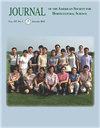新鲜番茄的一致遗传图谱和连锁图谱
IF 1.1
4区 农林科学
Q3 HORTICULTURE
Journal of the American Society for Horticultural Science
Pub Date : 2022-01-01
DOI:10.21273/jashs05110-21
引用次数: 2
摘要
结合4种不同番茄的2个双亲本F2分离群体的遗传重组数据,构建了生鲜番茄(Solanum lycopersicum)的首个共识遗传图谱。每个F2群体由位于美国主要新鲜市场番茄产区的不同学术番茄育种项目提名,并根据其育种项目的起源观察到番茄群体之间染色体重组率的差异。利用在两个种群中发现的335个常见单核苷酸多态性(SNP)位点构建的共识图谱跨越12条番茄染色体,长度为737.3 cM,其中2号染色体含有超过40%的总SNP,而4、5、7和10号染色体总共占不到10%的SNP。这335个SNP标记的遗传位置和物理位置之间存在高度共线性。在两个种群中分别检测到6553个SNP位点,其中有335个共同位点,这导致了一个扩展的共识遗传图谱。扩展图谱的总长度估计为1997.9 cM,这与之前对新鲜市场大果番茄的估计一致。利用335个SNP位点和73个SNP基因型核心生鲜番茄的共识图谱组合数据集,建立了生鲜番茄的连锁面板。利用连锁面板对番茄短纤维性状进行了遗传作图研究,验证了共识图谱和连锁面板对番茄研究的价值。链接面板中的等位基因信息将作为番茄SNP标记实施的基础,如基因分型平台和基因组关联图谱。本文章由计算机程序翻译,如有差异,请以英文原文为准。
A Consensus Genetic Map and Linkage Panel for Fresh-market Tomato
The first consensus genetic map in fresh-market tomato (Solanum lycopersicum) was constructed, combining genetic recombination data from two biparental F2 segregating populations derived from four different fresh-market tomatoes. Each F2 population was nominated by different academic tomato breeding programs located in major fresh-market tomato-producing areas of the United States, and chromosome-wide variation in recombination rates was observed between tomato populations based on the origin of their breeding programs. A consensus map constructed using 335 common single nucleotide polymorphism (SNP) sites found in both populations spanned 737.3 cM across 12 tomato chromosomes, with chromosome 2 containing more than 40% of the total SNPs and chromosomes 4, 5, 7, and 10 together representing less than 10% of the SNPs. There was a high degree of collinearity between the genetic and physical positions of those 335 SNP markers. The integration of 6553 SNP sites that were detected in either of the two populations with 335 common sites resulted in an extended consensus genetic map. The total length of the extended map was estimated to be 1997.9 cM, which was compatible with a previous estimate for large-fruited fresh-market tomato. A linkage panel for fresh-market tomato was also established using the combined dataset of the consensus map of 335 SNP loci and 73 SNP-genotyped core fresh-market tomatoes. An empirical genetic mapping study of the tomato brachytic trait using the linkage panel demonstrated the value of the consensus map and linkage panel for tomato research. The allelic information in the linkage panel will serve as a basis for SNP marker implementation, such as genotyping platforms and genomic association map, in tomato.
求助全文
通过发布文献求助,成功后即可免费获取论文全文。
去求助
来源期刊
CiteScore
3.80
自引率
0.00%
发文量
31
审稿时长
2 months
期刊介绍:
The Journal of the American Society for Horticultural Science publishes papers on the results of original research on horticultural plants and their products or directly related research areas. Its prime function is to communicate mission-oriented, fundamental research to other researchers.
The journal includes detailed reports of original research results on various aspects of horticultural science and directly related subjects such as:
- Biotechnology
- Developmental Physiology
- Environmental Stress Physiology
- Genetics and Breeding
- Photosynthesis, Sources-Sink Physiology
- Postharvest Biology
- Seed Physiology
- Postharvest Biology
- Seed Physiology
- Soil-Plant-Water Relationships
- Statistics

 求助内容:
求助内容: 应助结果提醒方式:
应助结果提醒方式:


